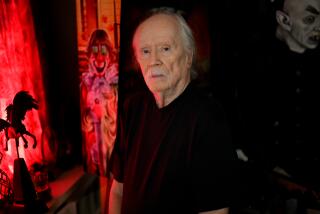A Caltech Alumnus Who Reached for the Stars
- Share via
Frank Capra, the Academy Award-winning director who died last week at 94, is best known for his classic films, such as “It’s a Wonderful Life.”
But the noted filmmaker was also a promising young scientist more than 70 years ago at Pasadena’s Caltech. Capra graduated in 1918--back when Caltech was still called Throop Polytechnic--with a degree in mechanical engineering and hopes of becoming a career scientist.
After a stint in the Army, however, Capra was unable to find steady work. He did odd jobs for three years, eventually stumbling into a job as a cameraman, gag writer and director at a small movie studio. That launched his career.
Though he abandoned the periodic table for the director’s chair, Capra maintained close ties with his alma mater all his life, sitting on various committees and donating generously to Caltech, according to school officials.
“He’s been involved in one way or another with Caltech since he arrived as a freshman in 1915,” said Thomas W. Anderson, a Caltech vice president. “He will be missed.”
In 1972, Capra gave the school his 14-acre ranch in Fallbrook. The San Diego County site, with its formal gardens, citrus groves and wooded paths, is used as a retreat by student research groups, school trustees and scientists at Caltech’s Jet Propulsion Lab.
The Sicilian-born filmmaker’s family immigrated to America when he was 6 and settled in Los Angeles. Capra graduated from Manual Arts High School at 15. He had his sights set on attending Throop, but the school wouldn’t take such young students, so he worked odd jobs for a year, saving up $700.
Ensconced at Throop the following fall, Capra hustled to make ends meet, working nights as a waiter at school, managing the student laundry and polishing engines at a Pasadena power plant between 3:30 a.m. and 7:30 a.m. for 25 cents an hour, according to his 1971 autobiography “The Name Above the Title.”
His family owned a lemon grove in Sierra Madre, and Capra rode the 15 miles back and forth to Caltech on what he described as “a secondhand, single-cylinder, belt-driven Flanders motorcycle, the kind you started up by pushing it on the run.”
When his father was killed in an accident during his sophomore year, Capra said he feared he would have to quit school to help support the family.
Instead, he recalled, “the good officials of Caltech loaned me the tuition fees for my last three college years, so that--out of my sundry jobs--I could send Mama 90 simoleons a month while finishing school.”
In addition to taking a full load of classes, Capra won a $250 scholarship as a freshman that allowed him to travel the country, perhaps observing characters that would later spring to life in movies such as “Mr. Deeds Goes to Town” and “You Can’t Take It With You.”
He also edited the undergraduate newspaper The Tech and was captain of his ROTC unit as a senior. During these years, there was little sign of the man who would later direct Claudette Colbert and Clark Gable in the romantic comedy “It Happened One Night.”
Instead, Capra undertook research on an incendiary bomb that won a commendation from the National Research Council. His senior thesis was entitled: “Conductivity of Picric Acid and its Salts.”
Back in 1966, when Capra received a distinguished alumnus award, the onetime engineer was lauded in a completely different way from the other black-tied astronauts, geologists, biochemists and physicists honored that night.
“His creations include some of the most popular and memorable films ever made,” said Lee DuBridge, then president of Caltech.
Capra’s accomplishments, DuBridge added, “demonstrate that a Caltech education is not a fatal handicap to a distinguished career in the arts.”
More to Read
Only good movies
Get the Indie Focus newsletter, Mark Olsen's weekly guide to the world of cinema.
You may occasionally receive promotional content from the Los Angeles Times.








